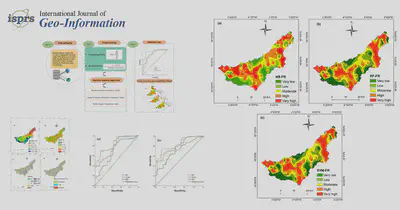Hybrid Machine Learning Approach for Gully Erosion Mapping Susceptibility at a Watershed Scale
Abstract
Gully erosion is a serious threat to the state of ecosystems all around the world. As a result, safeguarding the soil for our own benefit and from our own actions is a must for guaranteeing the longterm viability of a variety of ecosystem services. As a result, developing gully erosion susceptibility maps (GESM) is both suggested and necessary. In this study, we compared the effectiveness of three hybrid machine learning (ML) algorithms with the bivariate statistical index frequency ratio (FR), named random forest-frequency ratio (RF-FR), support vector machine-frequency ratio (SVM-FR), and naïve Bayes-frequency ratio (NB-FR), in mapping gully erosion in the GHISS watershed in the northern part of Morocco. The models were implemented based on the inventory mapping of a total number of 178 gully erosion points randomly divided into 2 groups (70% of points were used for training the models and 30% of points were used for the validation process), and 12 conditioning variables (i.e., elevation, slope, aspect, plane curvature, topographic moisture index (TWI), stream power index (SPI), precipitation, distance to road, distance to stream, drainage density, land use, and lithology). Using the equal interval reclassification method, the spatial distribution of gully erosion was categorized into five different classes, including very high, high, moderate, low, and very low. Our results showed that the very high susceptibility classes derived using RF-FR, SVM-FR, and NB-FR models covered 25.98%, 22.62%, and 27.10% of the total area, respectively. The area under the receiver (AUC) operating characteristic curve, precision, and accuracy were employed to evaluate the performance of these models. Based on the receiver operating characteristic (ROC), the results showed that the RF-FR achieved the best performance (AUC = 0.91), followed by SVM-FR (AUC = 0.87), and then NB-FR (AUC = 0.82), respectively. Our contribution, in line with the Sustainable Development Goals (SDGs), plays a crucial role for understanding and identifying the issue of “where and why” gully erosion occurs, and hence it can serve as a first pathway to reducing gully erosion in this particular area.
